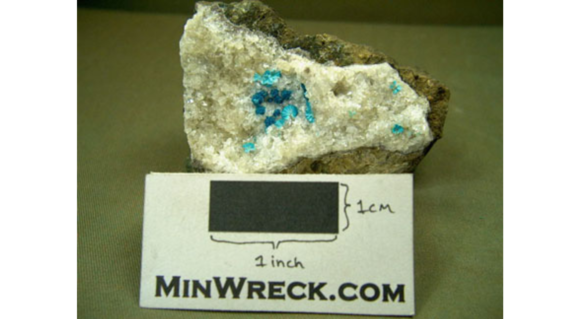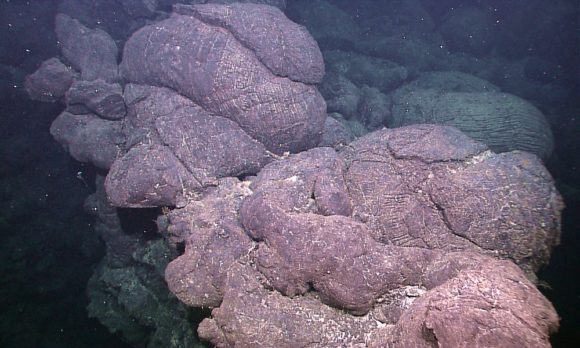Volcanic Basalt Lava is found all over the world. Often the host for beautiful minerals and crystals of quartz, calcite, agate and a host of zeolite minerals. The Amethyst deposits of Southern Brazil/Uruguay are considered the best quartz in basalt find, as are the fine Zeolite deposits of Southern India. Before India, many places were considered to be the world’s best zeolite deposits, like Scotland or Iceland.
It just goes to show, deposits of minerals in basalt rock deposits are well worth searching out in your local area. Consider the volcanic basalts of Oregon/Washington. Beautiful examples of rare and exotic minerals were once only known from these basalts, including, shockingly to some collectors, Cavansite!

Specimen of Cavansite from the first place it was found, in Oregon. Zeolite deposits found in volcanic deposits are well worth inspecting for rockhounding possibilities!
Found in volcanic lava that has interacted with water, zeolites are beautiful minerals which are found in a huge diversity of different appearances. They are known to form where enormous volcanic events have occurred in the ancient past when lava flows into a body of water.
The lava instantly chills, creating a unique bubbly, rounded texture called pillow basalt where within spaces between the rounded “pillows” grow delicate crystals of zeolites as steam chemically leaches the basalts and forms new minerals.
Steam may rise through the molten lava as well, where the rock may solidify before it escapes. This type of rock is called a vesicular basalt. Many minerals tend to form in the “bubbles” or vesicles in this type of rock.

A recently formed pillow basalt at the Galapagos Rift versus an ancient pillow basalt in the Bonin Islands, Japan. Zeolite minerals are found between the “lobes” of the lava.
A vesicular basalt boulder. The holes are known as vesicles and represent where rising gasses got trapped in the rock. Minerals often form in these vesicles.)
The Cape Lookout area is the remains of a volcanic island that emerged in the Miocene period, about 16 million years ago. Cracks in the earth formed, releasing lava into the sea which cooled on contact with the water, forming pillow basalts and bubbly vesicular basalts which further altered to form zeolite minerals in the pores.
Many rare zeolites are found here, not the ones you would typically see in the large, flashy specimens from India many collectors love, but equally as beautiful if you can appreciate tiny things. Minerals you may encounter are erionite, mordenite, clinoptilolite, and dachiardite. Often these are found with calcite and clay minerals, the latter can give specimens some nice color and visual depth.
Specimens from this area are typically small, but absolutely stunning especially under magnification. A good, readily available microscope to view your microminerals with is the Dino-Lite, which you can attach to your computer via USB.
On this page, our focus is on two collecting sites you can visit, though exploring the beach may yield many more discoveries. Keep an eye out for sprays and nodules of zeolite minerals in the rock, much of which occurs in vesicular basalt, which looks like Swiss cheese.
The first area is Short Beach. There should be a stairway near a creek where you can access the rocky beach below. Here you will find boulders of vesicular basalt that you can break up to yield minerals in the vesicles.
Bring a pocket lens or loupe with you so you can more easily see minerals in the vesicles. They will be somewhat obvious, appearing as white puffballs and sprays, but some may be more hidden.
There is said to be better collecting even still at Tunnel Beach, down the road to the south.
North of the tunnel, you will see pillow basalt cliffs. Formed as lava was ejected into the sea, these cliffs and the surrounding boulders are rich in zeolites and offer some of the best collecting in the area. Use the tunnel to access the beach.
Minerals: These localities are heaven especially to the micro-mount collector. Some beautiful photos of material from the surrounding area are on Mindat (these are copyrighted and we don’t care to hotlink, just click the links for some great photos).
Embed:
https://www.mindat.org/photo-750805.html
Caption: Found by Rudy Tschernich, famous PNW zeolite collector. 14 mm FOV Golden erionite hemispheres on a white backdrop, looking like a fried egg with a broken yolk
https://www.mindat.org/photo-750632.html
Tiny, bushlike mordenite in a tiny vesicle from Tunnel Beach. Found by Rudy Tschernich
https://www.mindat.org/photo-257230.html
About a 1 inch wide plate of green gray clinoptilolite on mordenite from Short Beach, collected by Bill Tompkins
https://www.mindat.org/photo-751603.html
Tiny, about 2.5mm vesicle of delicate golden erionite sprays. Found by Rudy Tschernich
Collecting Zeolites: To do the best job you can collecting these delicate specimens, you will need to be prepared to break the hard basalt rock. Use a heavy crack hammer and a chisel to smash the boulders open, revealing fresh material. Zeolites are extremely delicate and the freshest, nicest ones will be found unexposed inside the rocks.
As said above, loupe or hand lens will help you see what’s going on inside the tiny vesicles a lot better. Some of the most beautiful specimens from this location are extremely tiny so you may miss them without a lens.
Remember to wrap your specimens very carefully. Many of these specimens are extremely delicate to the point that even blowing on them may damage them. Do not wash anything very velvety, hairy, or puffy or even moisture can mat and destroy the crystals.
You will have to time your collecting with the tides at these locations. Be aware of the tides and weather conditions before you go to the beach and collect.
More Info:
https://www.mindat.org/loc-210854.html
https://www.mindat.org/loc-205422.html
https://www.netartsbaytoday.org/html/zeolites_of_oceanside.html
And, if the Cavansite deposit sends your imagination wild, check out this article:
https://www.mindat.org/article.php/964/Field+Trip+to+Cavansite+Type+Locaility
